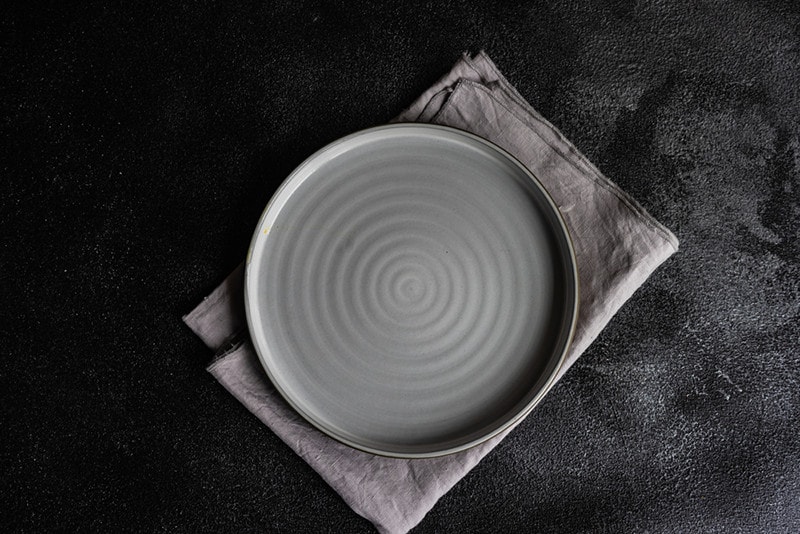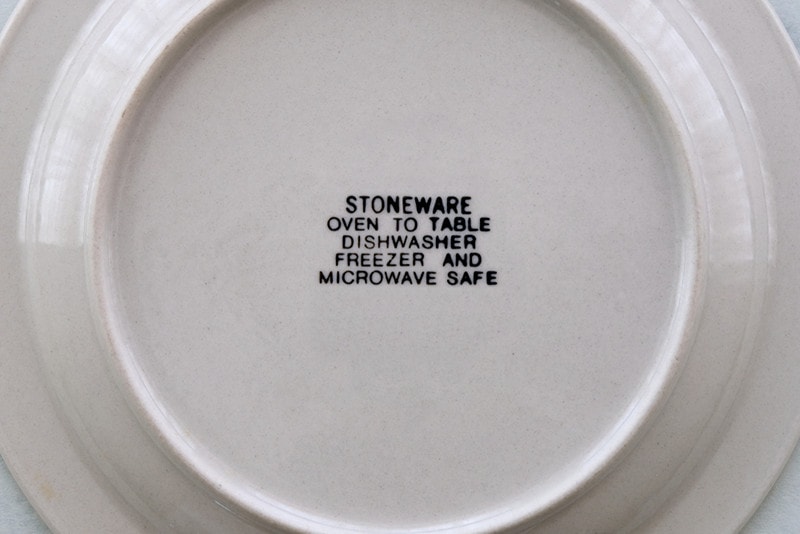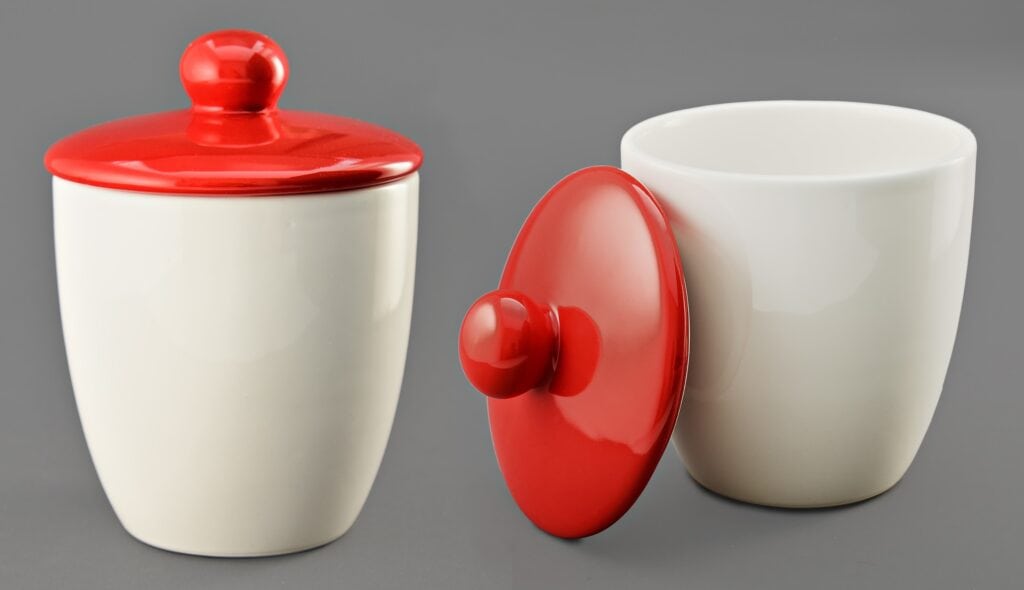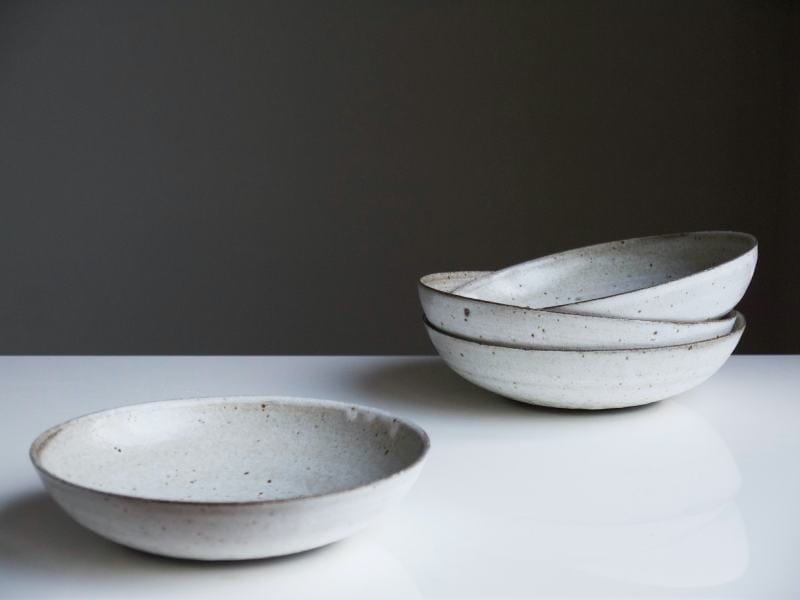Is Stoneware Microwave Safe? (Microwave Safety Tips)
-
- Last updated:

Stoneware is specifically made to withstand extreme heat and can easily handle 212°F (100°C)—the maximum effective temperature generated by most commercial microwaves. Does that mean stoneware is always microwave safe? For the most part, yes, it is.
However, certain glazes and paints don’t mix well with electromagnetic radiation produced by the microwave. And if there’s a crack in the dish, that can lead to poisoning. So, before you put any stoneware into the cooking cavity, look for a stamp on the bottom of the plate, cup, or mug that says “Microwave-Friendly”.
Read on to learn more about ceramics and how to use them properly!
What Is Stoneware? The Definition
This collective term describes many ceramics crafted from stoneware clay. Fired at above-average temps, stoneware is durable, non-porous, and long-lasting. It has a sandy texture and will chip before breaking. More importantly, it doesn’t melt when exposed to heat. Stoneware is perfect for dinnerware, and humanity has been using it for ages!

Can You Put Stoneware in the Microwave?
For stoneware, heat is never a problem because the clay is fired at extreme temps. So, you won’t have to keep a ceramic bowl or mug in the microwave for short periods so that it doesn’t crack or melt. High tolerance to heat is the main reason stoneware is slowly yet steadily replacing plastic dinnerware in the oven. It doesn’t break down or deform.
But we still encourage you to check the bottom of the stoneware to make sure it is, indeed, allowed in the cooking cavity. If the tag says it’s microwave-safe, you’re in the clear. Or it can be a tiny symbol with waves on it. Tags and symbols are also used to indicate that the ceramics can be put in a dishwasher or fridge.

Leaching Chemicals: What You Need to Know
Clay is a harmless material. However, stoneware is often glazed to give it a new color, ornament it, or make the body more resistant to natural elements. Without glazing, certain ceramics won’t be resistant to high moisture levels. The downside to this is that when the plates or cups are heated in the microwave for a long time, the high temps might make the glazing (and the lead that it contains) melt.
As a result, dangerous chemicals could leach into your food (or be released into the atmosphere if you’re cooking food on a stove). While lead poisoning happens rarely, there have already been documented cases that involved the use of stoneware. That’s why it’s so important to check the label on the tableware before you use it. That will only take a second!

Also, you can avoid potential hazards by never using these dishes:
- Brightly colored: Lead is commonly used to increase the brightness of certain colors, including various shades of red, orange, and yellow
- While handcrafted items are highly valued, they’re sometimes made in less-than-ideal conditions
- Glaze is a go-to material for decorating ceramic dishes, but as we just learned, it can be harmful. This is especially true when it’s deteriorated
- Antique pieces: The rule of thumb here is simple: the older the stoneware, the higher the chances of it contaminating your food when heated
- Non-stamped: Can’t find a “microwave-safe” tag? Then only use these dishes for display, not cooking, reheating, or eating/drinking
Lead Poisoning: Common Symptoms
One of the worst things about lead poisoning is that you can’t really taste or smell it. You’ll only realize that you’re in trouble when the symptoms start kicking in. Please, don’t take lead poisoning lightly because long-term exposure can result in catastrophic consequences like brain damage and even death. Here’s a quick look at the most prevalent side effects:
- Severe headache
- Abdominal pain
- Joint/muscle pain
- It gets harder to concentrate and remember things
- Abnormally high blood pressure
- Sudden mood swings
- Misshapen/low-count sperm
- Premature birth, stillbirth, or miscarriage
- Permanent brain damage and death
Avoid ceramics with glaze/lead, metallic finishing, and paint to protect yourself and your loved ones from poisoning.

Should You Go With Plastic Instead?
No, plastic isn’t a better pick compared to stoneware. Polymers have poor resistance to heat, which means your favorite plate will quite literally melt. Furthermore, if the plastic is rich in BPA, you might get poisoned. So, just like with stoneware, don’t forget to check the label. If you see a “microwave-safe” tag, then there’s nothing to worry about. That’s right: not ALL plastics are bad; some can be put in a microwave.
Is Stoneware Recyclable?
Technically, clay and stone products are biodegradable, but they take hundreds of years to break down. More than that, most recycling facilities can’t use them. To melt down a ceramic cookware set, you’ll have to expose it to extreme temperatures, which goes beyond the capabilities of the average recycling facility in the States or Canada (unless they’re designed to crush bricks). So, does that mean ceramics are not eco-friendly?
Well, not quite. If you put them in a landfill, clay mugs or plates will take a very long time to break down. On the bright side, they won’t hurt the environment unless the stoneware includes traces of lead. But, again, the impact on Mother Nature will be minimal. How do you dispose of ceramics, then? Donate them to a local charity or take them to a commercial recycling facility.

How Long Does It Last?
Ceramic materials last for thousands of years. Stoneware is brittle and will, most likely, crack if you accidentally drop it. But, if you take proper care of it, all the plates, cups, and whatnot will last for many generations. Durability: that’s the biggest appeal here. Ceramics are practically immune to high temperatures and can handle tough weather conditions.
That said, sudden spikes or drops in temperature will damage stoneware. When exposed to thermal shocks, even the toughest ceramics might break. Or, at the very least, they’ll develop cracks. A great example of this is when you put a pot on a stovetop. The difference in temps will make it crack. Also, if you just grabbed it from the fridge, give the dish 20–30 minutes to “recover” before it goes into the microwave.
Is Stoneware Dishwasher-Safe?
Stoneware is highly resistant to heat and can also handle average humidity levels. Still, leaving your ceramic mugs or dishes in the dishwasher for a long time is not recommended unless they are glazed. Also, if the stoneware is important to you (maybe it was passed down to you by your grandparents), it would be best to use hand washing instead.
Soapy water and a nylon brush will make cleaning it a breeze. And one more thing: avoid using commercial cleaners that are based on citrus juices. They might have a negative effect on the exterior. This is especially true for earthenware dishes (glazed and fired). If you’re the proud owner of mid-fire or high-fire ceramics, that won’t be a problem.

Conclusion
Stoneware has been around for ages, helping our ancestors build walls, enjoy food, and craft decorative pieces. Today, ceramics products are just as popular, mainly because of their durability, longevity, and aesthetically pleasing nature. On top of that, most plates, bowls, and cups crafted from clay are equally safe to put in a refrigerator, dishwasher, microwave, and oven.
Still, you need to check the label first. If the stoneware doesn’t have a tag on it that says it’s microwave-friendly, you shouldn’t test your luck. If you do, that might make the ceramic crack, break, and even leach lead into your meal. Other than that, your favorite ceramic dish should be safe to freeze, reheat, defrost, reheat, and cook in!
Featured Image Credit:
Contents

